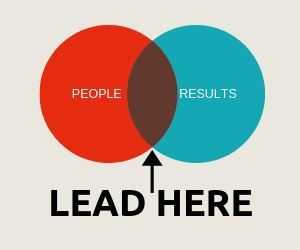
In my last post, I shared a simple analogy that equates leadership to rowing a row boat. The two oars of a row boat represent the two fundamental dynamics at play in leadership. These two dynamics are people and results.
The idea is simply this: As leaders, we need to be focused on the needs of the people we lead and on the organization’s need for results – at the same time. To lead effectively, we must operate these two elements simultaneously and with equal force, just like oars of a row boat. Otherwise, we go in circles.
While this idea of leadership as a balancing act between people and results sounds simple, let me be clear: Simple is not the same as easy.
There are three reasons this idea can be challenging to put into practice.
Leadership Entails a Lot of Moving Parts
Despite a focus on just two things – the needs of people and the need for results – each of these dynamics carries with it multiple elements and implications for leadership.
People, first of all, are unique and complex. Each of the people you lead has different skills, talents, and abilities. Each brings unique wants, needs, motivations, perspectives, and attitudes to work. Each person communicates differently. On the people side of leadership – this relational, interpersonal side – you need to adapt and adjust your leadership style and communication to each of your people, to interact on their unique wavelengths to meet their individual needs. One size does not fit all.
When we add to this our responsibility as leaders to drive results, the leadership story gets more complex. I bet, like all my clients, you’re busy. You and your team have a variety of tasks, projects, and initiatives to handle on any given day. As the leader, you not only have your own projects and deliverables, you’re responsible for ensuring the team meets its responsibilities as well. You need to set and manage their expectations, goals, and objectives. You need to secure resources for the team and help them remove obstacles. You need to pay attention to what they’re doing, assess their performance, coach them, and redirect them when they’re off track.
The vast and various components involved in leadership don’t mean that the people/results duality of leadership isn’t a useful or valid model. Just the opposite. When we separate leadership into the two big buckets of people and results, we gain a simple way to organize our various responsibilities, manage some of the chaotic nature of leadership, and get a better handle on our role as leader.
WHAT YOU CAN DO: Brainstorm a list of behaviors you routinely and intentionally engage in as a leader. You may want to do this over the course of a week or more as you observe and pay attention to the specific things you do in situations where you lead and influence others. You may also want to ask other people about your regular leadership behaviors.
Once you have a list that adequately represents your set of leadership behaviors, draw a t-chart on a piece of paper. Label one side people and the other results. Fit each behavior into one of the two columns. What do you notice as you look at the lists?
You Naturally Lean Toward Either People or Results
Long-standing psychometric research into human behavior, as measured by assessments based on the DISC model, indicates that each of us has a natural leaning toward being either task focused (results) or relationship focused (people). More recent neurological research supports this predisposition as well. While we all have the capacity for both task and relationship, each of us tends to start with or emphasize one over the other. One side is simply more comfortable.
The potential problem for us as leaders is that we automatically tend to lead from our comfort zone.
For example, if you’re a task-focused leader, you’ll tend to be more focused on expectations and goals, holding people accountable for outcomes, ensuring your team gets stuff done, and driving results.
On the other hand, as a relationship-focused leader, you’ll tend to be more focused on interacting with your people, listening to their perspectives, enhancing their experience of the workplace, and maintaining healthy relationships.
Both areas of focus are important to leadership, but our comfort with either the task side or the relationship side means our leadership often becomes unbalanced. If we’re not mindful about our most comfortable, automatic tendencies toward either results or people, we end up rowing with one oar.
WHAT YOU CAN DO: Think about your natural leaning between task and relationship. Which tends to be your preference or starting point? Do you tend to be more of a people-focused leader or results-focused leader? Your t-chart from the earlier exercise might give you good insight into this. If you’re still not sure, ask your team or others who work and interact with you regularly.
On the side that is not your natural preference, make a list of two or three behaviors you can begin practicing and focusing on to balance your leadership. Add them to your previous t-chart, then enact your plan.
Leadership Is a Dialectic
A dialectic is a condition where two seemingly opposing or contradictory forces co-exist and operate simultaneously within a system. These two forces compete internally for energy and primacy. Tension exists between the two forces. Yet there also exists an interrelatedness between them. They need each other. In a sense, they exist in one another, as symbolized by the Chinese concept of yin and yang.

When two dialectical forces exist within a human relationship – as in the relationship between you and your followers – it’s known as a relational dialectic.
A great example of this – and it mirrors the people/results duality in leadership precisely – is the classic dialectic found within all groups and teams. It’s the autonomy-connection dialectic, and it works like this: In every human group that comes together to achieve a common goal – whether it’s a work team, a sports team, or a family – there exists a constant tension between the individual needs of the group’s members (autonomy) and the need of the group to work together as one collective unit (connection). Individual needs and collective needs are always at play in a team, usually at the same time.
You undoubtedly have felt and experienced this phenomenon in various groups and teams you’ve been a part of in work and life. This dialectic is what Vince Lombardi was referring to in his famous quote: “Individual commitment to a group effort – that’s what makes a team work.”
In your leadership, the people-results dialectic plays out continuously and in a wide variety of ways. A team member, for example, may have personal issues that are getting in the way of results, yet the organization still needs the results. As a leader, your role is to help resolve the tension and reestablish alignment between the team member (people) and the needs of the organization (results).
As another example, the organization may need a new kind of result, and so it embarks upon a change initiative. Change, as we all know, impacts people in myriad, complex ways. People often resist and react negatively (even emotionally) toward change. Again, your job as leader is to manage the dialectic – to ensure people can effectively navigate the transition so that the change initiative can achieve its desired result.
For most leaders, it seems easiest and almost automatic for them to simply think and say: “It’s all about results!” They deny the dialectic; they overlook the fact that there are real people with real needs, perspectives, talents and agendas who are themselves integral to achieving those results.
Still other leaders deny the dialectic by overprotecting or coddling their people in ways that end up endangering or sacrificing results. They may fail to be clear on expectations or to hold people accountable, or they may avoid having difficult conversations with team members who are missing their numbers or treating others poorly.
Neither approach works. As a leader, you simply can’t be effective in the long run by choosing to emphasize either people OR results. Your leadership requires a focus on people AND results.
Remember: In a dialectic, the two forces need one another. They need to operate in harmony and balance. That’s your job as a leader, to create and maintain that balance.
WHAT YOU CAN DO: First, accept that this dialectic exists. It’s running quietly and constantly under the surface, like the operating system of your computer. The interplay of people and results is always there in your leadership. You can’t achieve results without other people, and if we don’t achieve results together, the organization will have no need for all these people (including you).
With your awareness of the dialectic, embrace it. How? By mindfully practicing those behaviors you added to your t-chart in the last exercise. Begin building muscle on the side opposite from your leadership strengths.
With practice, I’m confident you’ll begin to master this leadership dance, this interplay between the needs of your people and the needs of your organization. You will likely also find that your role as leader becomes easier.